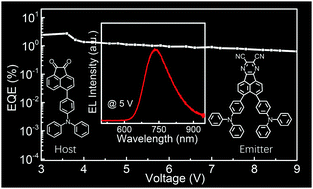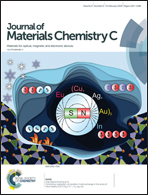Efficient near-infrared organic light-emitting diodes based on a bipolar host†
Abstract
The donor/acceptor (D/A) type π-conjugated molecule has superior characteristics which can be easily tuned. Herein, a D–A type host material 5-(4-(diphenylamino)phenyl)acenaphthylene-1,2-dione (ADO-TPA) was designed and synthesized with diphenylamino as the hole-transporting unit and acenaphthylene-1,2-dione as the electron-transporting unit within the molecule for the fabrication of near-infrared (NIR) organic light-emitting diodes (OLEDs). The thermal, photophysical and electrochemical properties of ADO-TPA were systematically investigated and the new host showed bipolar behavior. Significantly, the low turn on voltage of 3 V is achieved because of the narrow bandgap of ADO-TPA of about 2.14 eV. In particular, the device with 20 wt% of 3,4-bis(4-(diphenylamino)phenyl)acenaphtho[1,2-b]pyrazine-8,9-dicarbonitrile (APDC-DTPA) doped into the ADO-TPA host exhibited a maximum external quantum efficiency (EQE) of 2.7% with an emission peak of 735 nm.



 Please wait while we load your content...
Please wait while we load your content...